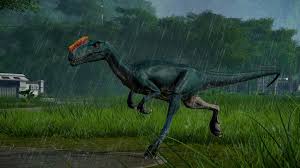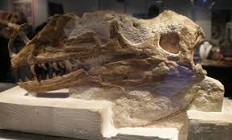
Proceratosaurus is a relatively lesser-known Dinosaur from the Late Jurassic period, approximately 166 million years ago. While it may not have the fame of Tyrannosaurus rex or Velociraptor, Proceratosaurus is an important part of the dinosaur record, and this 500-word exploration will delve into its classification, physical characteristics, habitat, and its role in our understanding of dinosaur evolution.
Proceratosaurus belongs to the theropod group of dinosaurs, specifically within the family Proceratosauridae. This group includes small to medium-sized carnivorous dinosaurs characterized by their bipedal stance, sharp teeth, and predatory behavior. Proceratosaurus was named for its distinctive feature: a small nasal horn or crest on its snout.
| Name: | Proceratosaurus dinosaurs |
| Size: | Around 10 to 13 feet in length , and weighed 600 to 700 pounds. |
| Main Facts: | Proceratosaurus had a distinctive small nasal horn on its snout, a unique feature among theropod dinosaurs, setting it apart. |
The first fossils of Proceratosaurus were discovered in England in the early 20th century. These fossils provided valuable insights into the diversity of theropod dinosaurs during the Jurassic period.n.

Proceratosaurus was a relatively small dinosaur, reaching lengths of around 10 to 13 feet (3 to 4 meters) and standing about 3 feet tall at the hips. Its most distinguishing feature was the small nasal horn or crest on its snout, which gives it its name. This horn was not as prominent as those found on later ceratopsian dinosaurs like Triceratops but was nonetheless unique among theropods.
In addition to its nasal horn, Proceratosaurus had sharp teeth, typical of theropods, which it used for hunting small prey. It had a long tail, a bipedal posture, and likely had feathers covering its body, although direct evidence of feathers has not been found in Proceratosaurus fossils.
Proceratosaurus lived during the Late Jurassic period, a time when the Earth's continents were arranged differently than they are today. The climate during this period was generally warm and humid, and the landscapes featured lush forests and diverse ecosystems.
As a carnivorous dinosaur, Proceratosaurus would have been a predator in its environment, likely preying on small and medium-sized animals, such as smaller dinosaurs, reptiles, and mammals. Its sharp teeth and relatively agile build would have made it an efficient hunter.
While much about its behavior remains speculative due to the limited fossil evidence, Proceratosaurus was likely a bipedal runner, capable of swift movement, as is common among theropods. It may have used its small nasal horn for display or intraspecific communication rather than for combat, unlike the larger horns of ceratopsian dinosaurs, which were used for defense and combat.
Proceratosaurus was a small carnivorous theropod dinosaur from the Late Jurassic period, measuring about 10 to 13 feet in length. It had a distinctive small nasal horn or crest on its snout, a unique feature among theropods. Its sharp teeth and agile build made it an efficient predator, likely preying on smaller animals.
Proceratosaurus lived in a warm and humid environment with lush forests. While its behavior remains somewhat speculative, it is classified as a typical bipedal, carnivorous dinosaur. Its relatively small size and nasal crest distinguish it from more famous theropods like Tyrannosaurus rex, adding to the diversity of prehistoric predators.
Proceratosaurus, a small theropod dinosaur from the Late Jurassic period, shares both similarities and differences with other dinosaurs, providing insights into the diversity of prehistoric life.
Proceratosaurus belongs to the theropod group, which is characterized by bipedal posture, sharp teeth, and carnivorous habits. This classification connects it with a wide range of predatory dinosaurs, including famous ones like Tyrannosaurus rex and Velociraptor.
Like many theropods, Proceratosaurus was a carnivorous predator, preying on smaller animals. Its sharp teeth and agile build were common traits among theropods adapted for hunting.
Proceratosaurus was relatively small, measuring about 10 to 13 feet in length, whereas some other theropods, like Tyrannosaurus rex, reached lengths of up to 40 feet or more.
One of the most distinctive features of Proceratosaurus was its small nasal horn or crest. While this feature was unique among theropods, it differed significantly from the more elaborate horns and frills seen in ceratopsian dinosaurs like Triceratops.
Proceratosaurus lived during the Late Jurassic period, while some other theropods, such as Tyrannosaurus rex, thrived during the Cretaceous period, millions of years later.
Proceratosaurus fossils have been found in England, whereas other famous theropods like Velociraptor are associated with different geographical regions, such as Mongolia.
The social behavior of Proceratosaurus remains speculative due to limited fossil evidence. In contrast, some theropods, like Velociraptor, are thought to have exhibited pack-hunting behaviors.